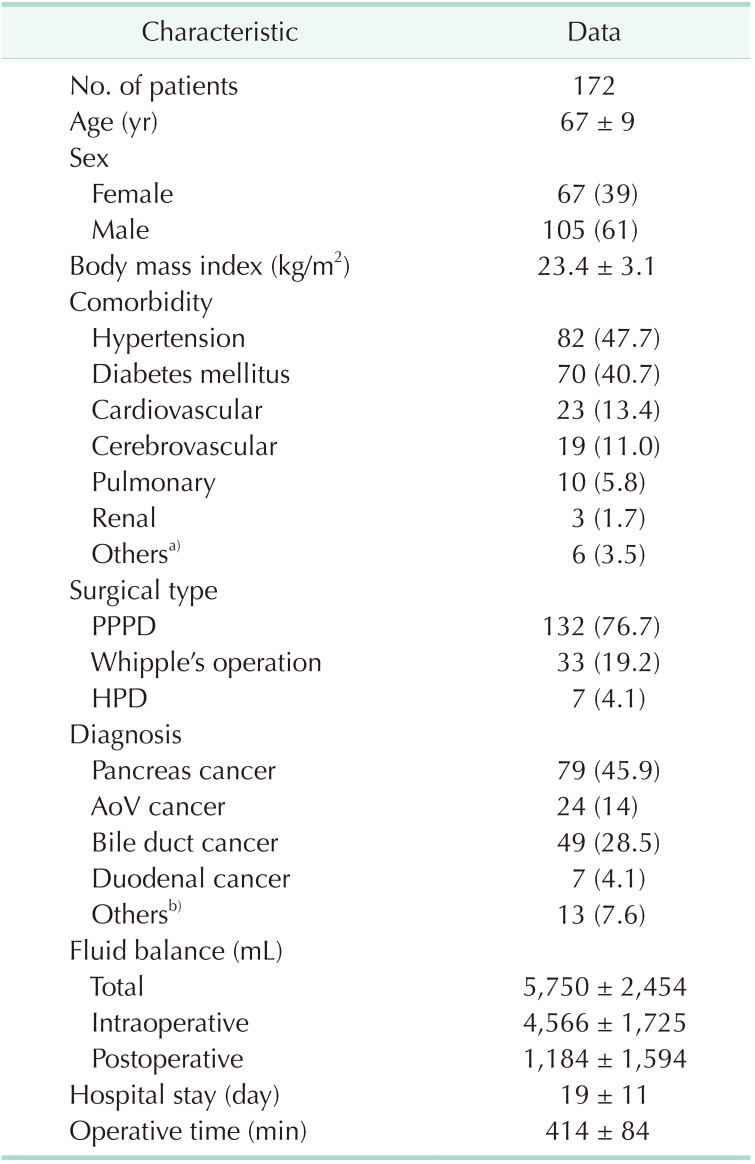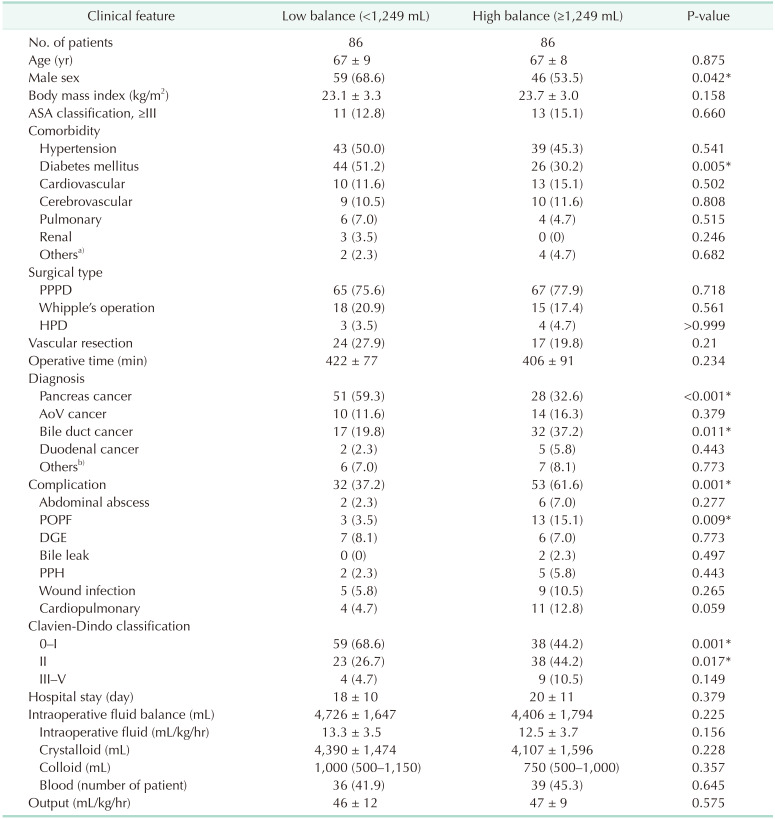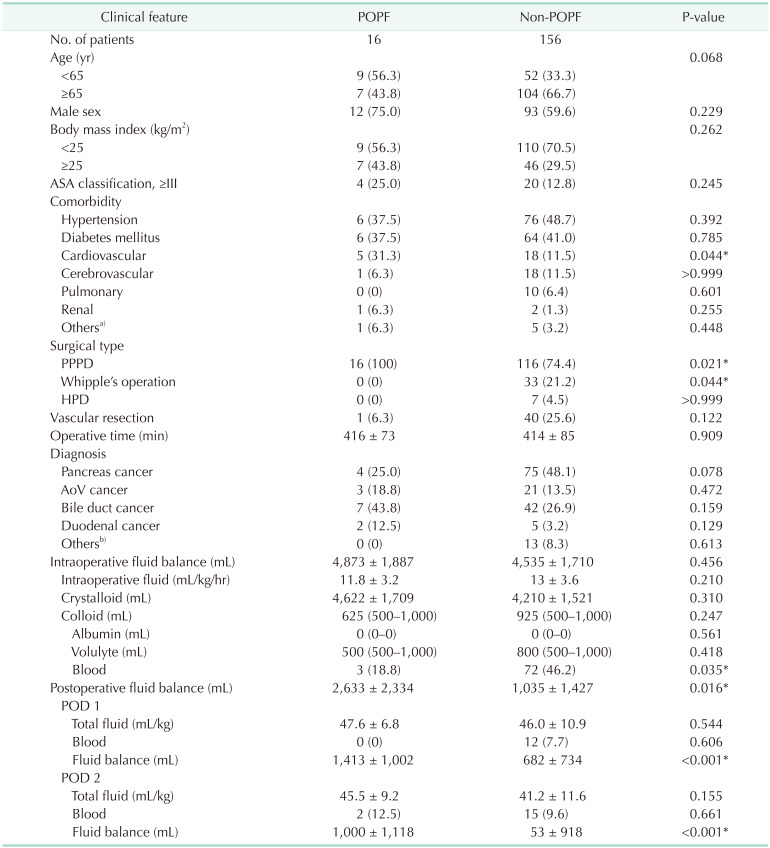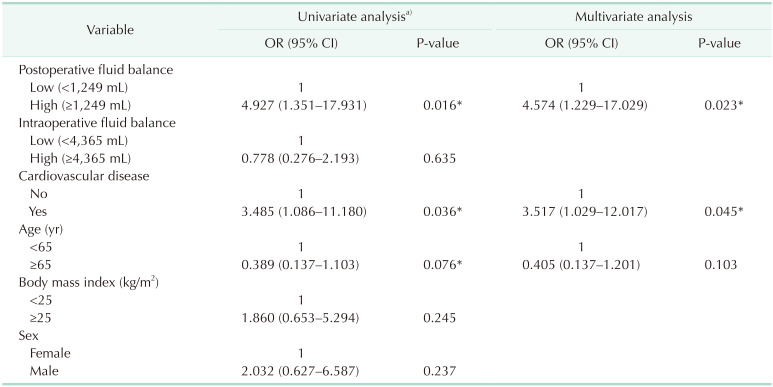1. Hu BY, Wan T, Zhang WZ, Dong JH. Risk factors for postoperative pancreatic fistula: analysis of 539 successive cases of pancreaticoduodenectomy. World J Gastroenterol. 2016; 22:7797–7805. PMID:
27678363.

2. Ellis RJ, Brock Hewitt D, Liu JB, Cohen ME, Merkow RP, Bentrem DJ, et al. Preoperative risk evaluation for pancreatic fistula after pancreaticoduodenectomy. J Surg Oncol. 2019; 119:1128–1134. PMID:
30951614.

3. Utsumi M, Aoki H, Nagahisa S, Nishimura S, Une Y, Kimura Y, et al. Preoperative predictive factors of pancreatic fistula after pancreaticoduodenectomy: usefulness of the CONUT score. Ann Surg Treat Res. 2020; 99:18–25. PMID:
32676478.

4. Eng OS, Goswami J, Moore D, Chen C, Gannon CJ, August DA, et al. Intraoperative fluid administration is associated with perioperative outcomes in pancreaticoduodenectomy: a single center retrospective analysis. J Surg Oncol. 2013; 108:242–247. PMID:
23907788.

5. Wright GP, Koehler TJ, Davis AT, Chung MH. The drowning whipple: perioperative fluid balance and outcomes following pancreaticoduodenectomy. J Surg Oncol. 2014; 110:407–411. PMID:
24861716.

6. Wang S, Wang X, Dai H, Han J, Li N, Li J. The effect of intraoperative fluid volume administration on pancreatic fistulas after pancreaticoduodenectomy. J Invest Surg. 2014; 27:88–94. PMID:
24665844.

7. Han IW, Kim H, Heo J, Oh MG, Choi YS, Lee SE, et al. Excess intraoperative fluid volume administration is associated with pancreatic fistula after pancreaticoduodenectomy: a retrospective multicenter study. Medicine (Baltimore). 2017; 96:e6893. PMID:
28562540.
8. Kulemann B, Fritz M, Glatz T, Marjanovic G, Sick O, Hopt UT, et al. Complications after pancreaticoduodenectomy are associated with higher amounts of intra- and postoperative fluid therapy: a single center retrospective cohort study. Ann Med Surg (Lond). 2017; 16:23–29. PMID:
28289542.

9. Weinberg L, Ianno D, Churilov L, Chao I, Scurrah N, Rachbuch C, et al. Restrictive intraoperative fluid optimisation algorithm improves outcomes in patients undergoing pancreaticoduodenectomy: a prospective multicentre randomized controlled trial. PLoS One. 2017; 12:e0183313. PMID:
28880931.

10. Melloul E, Lassen K, Roulin D, Grass F, Perinel J, Adham M, et al. Guidelines for perioperative care for pancreatoduodenectomy: Enhanced Recovery After Surgery (ERAS) recommendations 2019. World J Surg. 2020; 44:2056–2084. PMID:
32161987.

11. Shen Y, Cai G, Gong S, Yan J. Perioperative fluid restriction in abdominal surgery: a systematic review and meta-analysis. World J Surg. 2019; 43:2747–2755. PMID:
31332489.

12. Myles PS, Bellomo R, Corcoran T, Forbes A, Peyton P, Story D, et al. Restrictive versus liberal fluid therapy for major abdominal surgery. N Engl J Med. 2018; 378:2263–2274. PMID:
29742967.

13. Myles P, Bellomo R, Corcoran T, Forbes A, Wallace S, Peyton P, et al. Restrictive versus liberal fluid therapy in major abdominal surgery (RELIEF): rationale and design for a multicentre randomised trial. BMJ Open. 2017; 7:e015358.

14. Pulvirenti A, Ramera M, Bassi C. Modifications in the International Study Group for Pancreatic Surgery (ISGPS) definition of postoperative pancreatic fistula. Transl Gastroenterol Hepatol. 2017; 2:107. PMID:
29354764.

15. Wente MN, Bassi C, Dervenis C, Fingerhut A, Gouma DJ, Izbicki JR, et al. Delayed gastric emptying (DGE) after pancreatic surgery: a suggested definition by the International Study Group of Pancreatic Surgery (ISGPS). Surgery. 2007; 142:761–768. PMID:
17981197.

16. Wente MN, Veit JA, Bassi C, Dervenis C, Fingerhut A, Gouma DJ, et al. Postpancreatectomy hemorrhage (PPH): an International Study Group of Pancreatic Surgery (ISGPS) definition. Surgery. 2007; 142:20–25. PMID:
17629996.

17. Dindo D, Demartines N, Clavien PA. Classification of surgical complications: a new proposal with evaluation in a cohort of 6336 patients and results of a survey. Ann Surg. 2004; 240:205–213. PMID:
15273542.
18. Kwon HJ, Ha HT, Choi YY, Kim SG. The effects of the end-to-side inverted mattress pancreaticojejunostomy on postoperative pancreatic fistula: a single surgeon’s experience. Ann Surg Treat Res. 2015; 89:61–67. PMID:
26236694.

19. Lee JY, Kim EY, Lee JS, Lee SH, Na GH, Hong TH, et al. A novel pancreaticogastrostomy method using only two transpancreatic sutures: early postoperative surgical results compared with conventional pancreaticojejunostomy. Ann Surg Treat Res. 2015; 88:299–305. PMID:
26029674.

20. Thompson SK, Chang EY, Jobe BA. Clinical review: healing in gastrointestinal anastomoses, part I. Microsurgery. 2006; 26:131–136. PMID:
16518804.

21. Grant FM, Protic M, Gonen M, Allen P, Brennan MF. Intraoperative fluid management and complications following pancreatectomy. J Surg Oncol. 2013; 107:529–535. PMID:
23136127.

22. Grant F, Brennan MF, Allen PJ, DeMatteo RP, Kingham TP, D'Angelica M, et al. Prospective randomized controlled trial of liberal vs restricted perioperative fluid management in patients undergoing pancreatectomy. Ann Surg. 2016; 264:591–598. PMID:
27355261.

23. Sandini M, Fernández-Del Castillo C, Ferrone CR, Ruscic KJ, Eikermann M, Warshaw AL, et al. Intraoperative fluid administration and surgical outcomes following pancreaticoduodenectomy: external validation at a tertiary referral center. World J Surg. 2019; 43:929–936. PMID:
30377724.








 PDF
PDF Citation
Citation Print
Print




 XML Download
XML Download